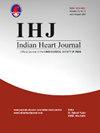Comparative evaluation of machine learning models versus TIMI score in ST-segment-elevation myocardial infarction patients
IF 1.8
Q3 CARDIAC & CARDIOVASCULAR SYSTEMS
引用次数: 0
Abstract
Background
Risk stratification is an integral component of ST-segment-elevation myocardial infarction (STEMI) management practices. This study aimed to derive a machine learning (ML) model for risk stratification and identification of factors associated with in-hospital and 30-day mortality in patients with STEMI and compare it with traditional TIMI score.
Methods
This was a single center prospective study wherein subjects >18 years with STEMI (n = 1700) were enrolled. Patients were divided into two groups: training (n = 1360) and validation dataset (n = 340). Six ML algorithms (Extra Tree, Random Forest, Multiple Perceptron, CatBoost, Logistic Regression and XGBoost) were used to train and tune the ML model and to determine the predictors of worse outcomes using feature selection. Additionally, the performance of ML models both for in-hospital and 30-day outcomes was compared to that of TIMI score.
Results
Of the 1700 patients, 168 (9.88 %) had in-hospital mortality while 30-day mortality was reported in 210 (12.35 %) subjects. In terms of in-hospital mortality, Random Forest ML model (sensitivity: 80 %; specificity: 74 %; AUC: 80.83 %) outperformed the TIMI score (sensitivity: 70 %; specificity: 64 %; AUC:70.7 %). Similarly, Random Forest ML model (sensitivity: 81.63 %; specificity: 78.35 %; AUC: 78.29 %) had better performance as compared to TIMI score (sensitivity: 63.26 %; specificity: 63.91 %; AUC: 63.59 %) for 30-day mortality. Key predictors for worse outcomes at 30-days included mitral regurgitation on presentation, smoking, cardiogenic shock, diabetes, ventricular septal rupture, Killip class, age, female gender, low blood pressure and low ejection fraction.
Conclusions
ML model outperformed the traditional regression based TIMI score as a risk stratification tool in patients with STEMI.
st段抬高型心肌梗死患者机器学习模型与TIMI评分的比较评价。
背景:风险分层是st段抬高型心肌梗死(STEMI)管理实践的一个组成部分。本研究旨在建立一种机器学习(ML)模型,用于STEMI患者住院和30天死亡率相关因素的风险分层和识别,并将其与传统的TIMI评分进行比较。方法:这是一项单中心前瞻性研究,入组年龄为18岁的STEMI患者(n=1700)。患者分为两组:训练组(n=1360)和验证组(n=340)。六种机器学习算法(Extra Tree, Random Forest, Multiple Perceptron, CatBoost, Logistic Regression和XGBoost)用于训练和调整机器学习模型,并使用特征选择确定较差结果的预测因子。此外,将ML模型在住院和30天预后方面的表现与TIMI评分进行比较。结果:1700例患者中,住院死亡168例(9.88%),30天死亡210例(12.35%)。在住院死亡率方面,随机森林ML模型(敏感性:80%;特异性:74%;AUC: 80.83%)优于TIMI评分(敏感性:70%;特异性:64%;AUC: 70.7%)。同样,Random Forest ML模型(灵敏度:81.63%;特异性:78.35%;AUC: 78.29%)表现优于TIMI评分(敏感性:63.26%;特异性:63.91%;AUC: 63.59%)。30天不良预后的主要预测因素包括二尖瓣返流、吸烟、心源性休克、糖尿病、室间隔破裂、Killip分级、年龄、女性、低血压和低射血分数。结论:作为STEMI患者的风险分层工具,ML模型优于传统的基于回归的TIMI评分。
本文章由计算机程序翻译,如有差异,请以英文原文为准。
求助全文
约1分钟内获得全文
求助全文
来源期刊

Indian heart journal
CARDIAC & CARDIOVASCULAR SYSTEMS-
CiteScore
2.60
自引率
6.70%
发文量
82
审稿时长
52 days
期刊介绍:
Indian Heart Journal (IHJ) is the official peer-reviewed open access journal of Cardiological Society of India and accepts articles for publication from across the globe. The journal aims to promote high quality research and serve as a platform for dissemination of scientific information in cardiology with particular focus on South Asia. The journal aims to publish cutting edge research in the field of clinical as well as non-clinical cardiology - including cardiovascular medicine and surgery. Some of the topics covered are Heart Failure, Coronary Artery Disease, Hypertension, Interventional Cardiology, Cardiac Surgery, Valvular Heart Disease, Pulmonary Hypertension and Infective Endocarditis. IHJ open access invites original research articles, research briefs, perspective, case reports, case vignette, cardiovascular images, cardiovascular graphics, research letters, correspondence, reader forum, and interesting photographs, for publication. IHJ open access also publishes theme-based special issues and abstracts of papers presented at the annual conference of the Cardiological Society of India.
 求助内容:
求助内容: 应助结果提醒方式:
应助结果提醒方式:


